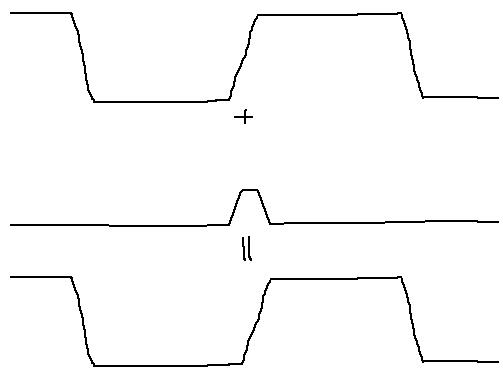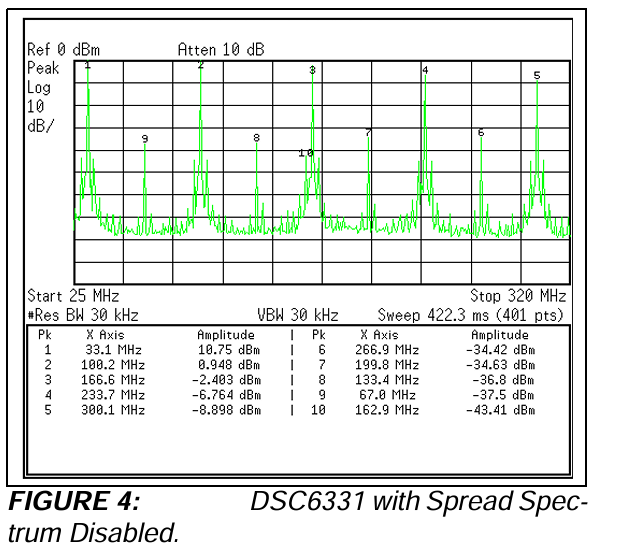Even harmonics have to do with the balance (evenness, if you will!) of the waveform. An ideal 50% square wave is perfectly balanced (an odd function, the second half is inverse of the first half) so has none, only odd harmonics. A real signal is never quite this well balanced, and we can see this trend from the referenced spectrum.
The spectrum of a real square wave can be described in terms of these aspects, or modifications, and their direct consequences in the Fourier domain:
- Starting with a square wave, we have odd harmonics (1, 3, 5, ...) going as 1/N amplitude, i.e. an overall -20dB/dec trend.
- The trend continues until the risetime; the waveform is actually trapezoidal, and the slope of that trapezoid corresponds to the next breakpoint, beyond which it goes as 1/N^2.
- Which goes until the corner rate; the waveform is actually a piecewise quadratic, and the curvature of the corners of the slopes correpsonds to the next breakpoint, beyond which it goes as 1/N^3.
- And so on. Or perhaps the cutoff is more exponential in nature, and harmonics just kind of tank beyond some point. (There's never a hard cutoff in reality, a "brick wall filter" that would give rise to Gibbs phenomenon -- though we can construct filters precise enough to approach it, e.g. sinc interpolation in DSP filters.)
These trends correspond with aspects of pure waveforms, pieced together to make one franken-waveform. Consider the waveform series produced by integrating the square wave: you get a triangle, then a piecewise parabola, and so on; the harmonics go as 1/N, 1/N^2, ... . These correspond to the breakpoints above, where some smaller aspect of the waveform has been piecewise patched together with a scaled segment of the given waveform.
At this point, we have the trend of harmonics dropping off, but no even harmonics:
Consider the case for the timing being slightly off. Maybe it's 49.9% instead of 50%. The source might be an ideal 50% logic function (like a type-T flip-flop), but minor differences in propagation delay (rising vs. falling) create an imbalance. We can express this as the sum of an ideal 50% square wave, plus a tiny pulse of the time difference, aligned just such that it apparently distorts the duty cycle:

This short pulse has a flat spectrum until frequencies comparable to its duration, at which point harmonics go as 1/N, and then by risetime and curvature and so on. (Actually it's a sin(f T/D) thing and more complicated than that, but this hand-wave captures the general roll-off of it anyway.)
The rise and fall can be asymmetrical, in which case we have two pulses, one up, one down, of different rates. We have a spikier difference waveform, which may result in a different trend for the harmonics up to the break point.
CMOS logic outputs are inherently asymmetrical: PMOS performs about 2.5 times poorer than NMOS (that is, in terms of capacitance times RDS(on), or capacitance divided by gm), and we make up for that by using, usually double the area PMOS than NMOS, as a compromise between increasing node capacitance (makes both edges run slower) and reduced current capacity (drives a load e.g. trace + pin capacitance slower). Typical LVCMOS pin drivers are 30-50Ω RDS(on) pulling down, and 50-80Ω pulling up.
It's likely this is what the waveform in question is doing: the slope and curvature of the rising and falling edges aren't symmetrical, and the difference dictates even harmonics, in this case rising to a point, then falling together with odd harmonics as overall risetime takes over.
Out at 720MHz, you are likely to see a forest of peaks, spaced 24MHz apart, and more or less even in amplitude from one to the next; clusters of these may be selected by various filtering elements inherent to the system's EMC profile (shape and orientation of traces, PCB, connectors, etc.), resonances which can be broad (a rounded "forest canopy" of peaks) or very sharp (one harmonic happens to land within the passband and stands out above the rest).
But just as well, you don't mention if there are other sources in the system: a receiver input, a PLL, other oscillators, etc.; the 720MHz tone might not be related to the 24MHz at all.
As you do not give schematic, datasheets of relevant components, timing requirements (e.g. jitter), the particular offending spectrum, PCB layout, and arrangement of the physical system in test (e.g. photos), I cannot comment further on your EMC situation, in terms of what exactly is going on, nor what possible solutions might apply.
Understand that EMC problems are holistic in nature: potentially any aspect of the system (component value, type, trace dimensions, board outline, enclosure, connectors, cable orientation, etc.) may be relevant at some frequency or another. There is very little that can be assessed without the above data; and even so, diagnosis is lengthy and not well suited to this venue (a simple one-question one-answer format). If you are having persistent difficulty, and are unable to publicly discuss the project in such detail, I would suggest engaging a local EMC expert to assess your project.


